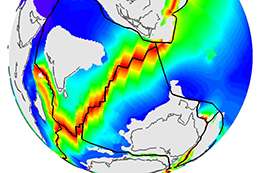Noise reduction necessary for more accurate study of Earth's plate movements

(Phys.org)—The mystery of erratic changes in the history of Earth's past and current plate motions has been cracked by academics from The Australian National University.
Dr Giampiero Iaffaldano, from the Research School of Earth Sciences in the ANU College of Physical and Mathematical Sciences, led a team that found true changes in plate motions occur on timescales no shorter than a few million years.
"The scenario arising from recent data was puzzling because plates appeared to move erratically and significantly over geologically-short periods of less than one million years," said Dr Iaffaldano.
"This posed a conundrum, as the forces that would be required to explain their sudden motions far exceed the most optimistic estimates we could make."
Dr Iaffaldano's research focused on the detailed records of plate motions across the mid-oceanic ridges in the South Pacific, Indian and Atlantic Oceans. After accounting for data noise – the portion of data that was unrelated to Earth's plate motions – he found that true changes in plate motions occur on timescales no shorter than five million years.
"A major discovery of the study is that, upon noise reduction, true changes in plate motions occur on timescales no shorter than a few million years. This yields simpler movement patterns and more plausible dynamics," he said.
"We showed that noise is in fact a significant bias to our understanding of the forces shaping Earth's surface, particularly as more and more measurements of plate motions are made available.
"This does not mean that these measurements are wrong, but we need to reduce noise as much as possible before making any geophysical conclusions. In our study we provide for the first time a method to do so in a simple and efficient way, by statistically determining the likelihood of a certain plate-motion change at a given time in the geologic past."
Dr Iaffaldano's findings are published in Nature Communications.
Journal information: Nature Communications
Provided by Australian National University



















